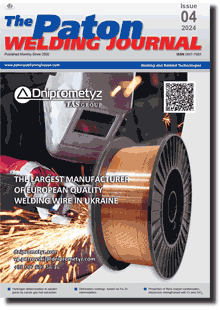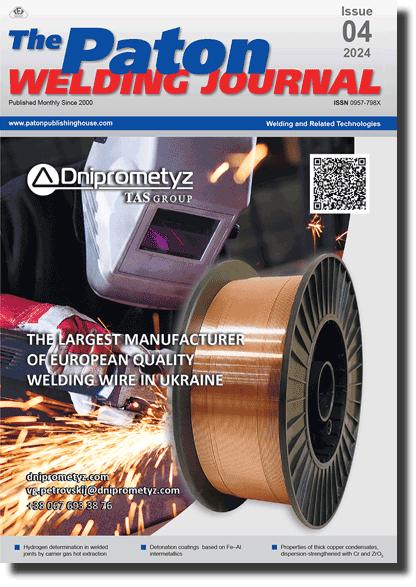| 2024 №04 (07) |
DOI of Article 10.37434/tpwj2024.04.01 |
2024 №04 (02) |

The Paton Welding Journal, 2024, #4, 3-10 pages
Parameters and challenges for reliable hydrogen determination in welded joints by carrier gas hot extraction
M. Rhode1,2, T. Mente1, T. Kannengiesser1,2
1Bundesanstalt für Materialforschung und -prüfung (BAM), Department 9 - Component Safety, Berlin, Germany. E-mail: michael.rhode@bam.de2Otto-von-Guericke-University, Institute for Materials Testing and Research, Magdeburg, Germany
Abstract
For the hydrogen-based energy economy of tomorrow, the construction of the necessary infrastructure will play a central role. Most materials used to date, such as welded steels, can be prone to hydrogen embrittlement under certain conditions. This includes the classic delayed cold cracking during welding as well as degradation phenomena during service of components in hydrogen-containing environment. For the evaluation of any hydrogen effect, for example, on the mechanical properties of a welded metallic material, the hydrogen content must be precisely determined. In the case of weld seams, the carrier gas hot extraction (CGHE) according to ISO 3690 is meanwhile state-of-the-art. CGHE is based on accelerated hydrogen degassing due to the thermal activation of hydrogen at elevated temperatures. In addition to the quantification of hydrogen, thermal desorption analysis (TDA) with varying heating rates can be used to determine and evaluate the hydrogen trapping at microstructural defects in the material. For both techniques, experimental and metrological influences must be considered, which have a major effect on the result. For example, ISO 3690 suggests different sample geometries and minimum extraction times for CGHE. This study summarizes the results and experiences of numerous investigations at the Federal Institute for Materials Research and Testing (BAM) with different sample temperatures and geometries (ISO 3690 type B and cylindrical TDA samples) regarding the influence of the sample surface (polished/welded), measurement accuracy depending on the sample volume and the insufficient monitoring of the effect of PI control on the extraction temperature. A deviating extraction temperature from the target temperature can significantly falsify the measurement results. Based on the results, methods are shown which allow the desired extraction temperature to be reached quickly without physically interfering with the measuring equipment. This serves to significantly improve the reliability of the hydrogen measurement through increased signal stability and accelerated hydrogen desorption. In general, an independent temperature measurement with dummy samples is recommended for the heating procedure of choice to exclude possible undesired temperature influences before the measurement. The methods described can be transferred directly to industrial applications.
Keywords: welding, hydrogen measurement, carrier gas hot extraction, ISO 3690, thermal desorption analysis
Received: 14.03.2024
Received in revised form: 09.04.2024
Accepted: 13.05.2024
References
1. Rhode, M., Kannengießer, T. (2021) Fügetechnik für die Wasserstoffökonomie - Werkstoffe, Schweißtechnologien, Perspektiven. In: DVS-Berichte 373. DVS-Media GmbH, Düsseldorf.2. Steiner, D., Marewski, U. et al. (2023) DVGW-Project SyWeSt H2 - Final report. Study funded by DVGW e.V. https://www.dvgw.de/medien/dvgw/forschung/berichte/g202006-sywesth2-staehle.pdf
3. ISO 3690:2018: Welding and allied processes - Determination of hydrogen content in arc weld metal.
4. ANSI/AWS A4.3-93:2006: Standard methods for determination of the diffusible hydrogen content of martensitic, bainitic, and ferritic steel weld metal produced by arc welding.
5. Padhy, G.K., Komizo, Y.I. (2013) Diffusible hydrogen in steel weldments - a status review. Transact. of the Japanese Welding Research Institute, 1, 39-62.
6. Jenkins, N., Hart, P.H.M. et al. (1997) An evaluation of rapid methods for diffusible weld hydrogen. Welding J. 76(1), 1s-10s.
7. Rhode, M., Schaupp, T. et al. (2019) Hydrogen determination in welded specimens by carrier gas hot extraction - a review on the main parameters and their effects on hydrogen measurement. Welding in the World, 63, 511-526. https://doi.org/10.1007/s40194-018-0664-9
8. Rhode, M. (2016) Hydrogen diffusion and effect on degradation in welded microstructures of creep-resistant low-alloyed steels: BAM-Dissertationsreihe 148, Berlin.
9. Salmi, S., Rhode, M. et al. (2015) Hydrogen determination in 22MnB5 steel grade by use of carrier gas hot extraction technique. Welding in the World, 59, 137-144. https://doi.org/10.1007/s40194-014-0186-z
10. Rhode, M., Mente, T. et al. (2018) Hydrogen trapping in T24 Cr-Mo-V steel weld joints - microstructure effect vs. experimental influence on activation energy for diffusion. Welding in the World, 62, 277-287. https://doi.org/10.1007/s40194-017-0546-6
11. N.N. (2023) Emission coefficients of different materials, accessed on 2023-05-18. http://www.scigiene.com/pdfs/428_InfraredThermometerEmissivitytablesrev. pdf
12. Rhode, M., Muenster, C. et al. (2017) Influence of experimental conditions and calculation method on hydrogen diffusion coefficient evaluation at elevated temperatures. In: Proc. of Inter. Hydrogen Conf. (IHC 2016) on Materials Performance in Hydrogen Environments. Eds by B.P. Somerday, P. Sofronis. ASME Press, 495-503. https://doi.org/10.1115/1.861387_ch56
13. (2017) ISO/DIS 3690: Result and Comment. IIW-Doc. IIE-760-18: Intermediate Meeting of IIW Commission II-E, Genua, Italy.
14. (2017) Comments on ISO/DIS 3690 by Japan Welding Engineering Society. IIW-Doc. II-E-750-17: Intermediate Meeting of IIW Commission II-E, Genua, Italy.
15. Rhode, M., Nietzke, J. et al. (2022) Hydrogen diffusion and desorption characteristics of a CoCrFeMnNi high entropy and a CoCrNi medium entropy alloy. In: Proc. of 4th Inter. Conf. on Steel and Hydrogen. Pap. H03, 11 pages. Ed. by Duprez L . OCAS, Ghent, Belgium.
Suggested Citation
M. Rhode, T. Mente, T. Kannengiesser (2024) Parameters and challenges for reliable hydrogen determination in welded joints by carrier gas hot extraction. The Paton Welding J., 04, 3-10.The cost of subscription/purchase order journals or individual articles
| Journal/Currency | Annual Set | 1 issue printed |
1 issue |
one article |
| TPWJ/USD | 384 $ | 32 $ | 26 $ | 13 $ |
| TPWJ/EUR | 348 € | 29 € | 24 € | 12 € |
| TPWJ/UAH | 7200 UAH | 600 UAH | 600 UAH | 280 UAH |
| AS/UAH | 1800 UAH | 300 UAH | 300 UAH | 150 UAH |
| AS/USD | 192 $ | 32 $ | 26 $ | 13 $ |
| AS/EUR | 180 € | 30 € | 25 € | 12 € |
| SEM/UAH | 1200 UAH | 300 UAH | 300 UAH | 150 UAH |
| SEM/USD | 128 $ | 32 $ | 26 $ | 13 $ |
| SEM/EUR | 120 € | 30 € | 25 € | 12 € |
| TDNK/UAH | 1200 UAH | 300 UAH | 300 UAH | 150 UAH |
| TDNK/USD | 128 $ | 32 $ | 26 $ | 13 $ |
| TDNK/EUR | 120 € | 30 € | 25 € | 15 € |
AS = «Automatic Welding» - 6 issues per year;
TPWJ = «PATON WELDING JOURNAL» - 12 issues per year;
SEM = «Electrometallurgy Today» - 4 issues per year;
TDNK = «Technical Diagnostics and Non-Destructive Testing» - 4 issues per year.


